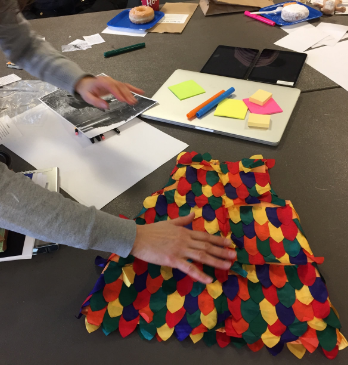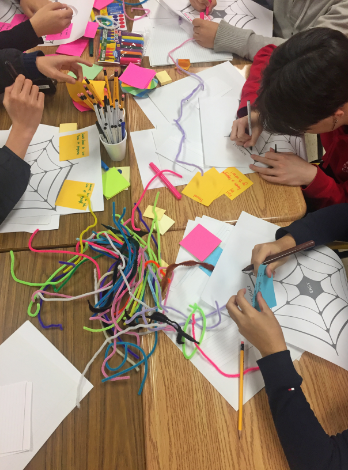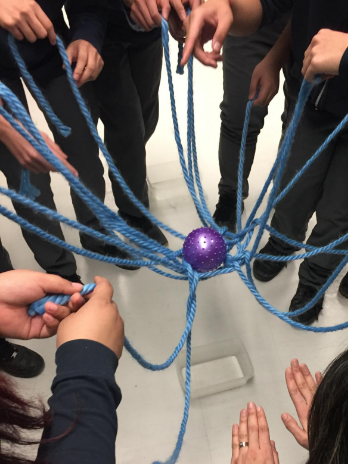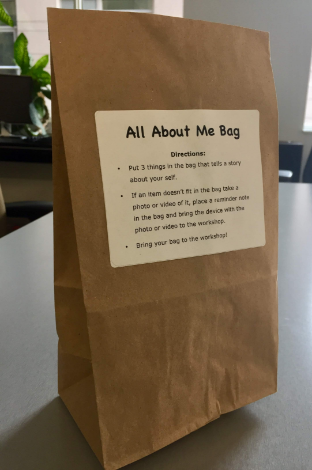Workshops
Storytelling can help us articulate our thoughts, feelings, and experiences; it can build confidence and create a sense of belonging and connection. Storytelling workshops can be a community experience that helps us uncover and express our stories.
During our workshops, participants reflected on their learning experiences and shared their stories of learning challenges and successes. Some expressed their stories with a voice recording, a drawing, written words or a video. Many shared their stories with the world by publishing them on the Storytelling website. Workshops were co-designed and facilitated with the goal to engage all individuals within diverse groups in finding, telling and sharing stories of learning.

Web Theme Storytelling Workshop
The Web Theme workshop took approximately three hours and has two parts which were run on separate days. The structure of the workshop looks like this:
Day one: activities were aimed at helping students self-reflect on personal learning experiences and discover their stories about learning they wanted to share with the world. These activities included Web of strings and Spider web story mapping.
Day two: Demo the Digital Story Building Tool, support participants in assembling their stories in the tool and publish to the Storytelling site. Students are encouraged to take photos, videos or use other creative mediums to help tell their digital stories—this can be assigned as homework.
We facilitated this workshop several times with high school students and their teachers in school classrooms. Students who attended the workshops were newcomers, refugees, and spoke various languages.
You can get a more detailed description of the process and activities in the facilitation guide. Use all or some of the of the activities; adapt and remix and then share your new resource back with the community!

Resources used in this workshop
Highschool Storytelling Workshop Guide
Web of Strings: group activity
Web of Learning Mapping: activity
Web of Learning Mapping: PDF template
Simplified Contributor License Agreement: docx
What we Learned at the workshops
A story about the Web of strings activity: In one workshop we didn’t have enough strings for everyone to participate in the web of strings activity. We came up with the solution to cut the strings in half to double the number. What we found was shorter strings meant those holding the strings needed to be physically closer together, even touching shoulder-to-shoulder. We also noticed that with a tighter circle the sound (there was a lot of cheering, laughing, oohing and awing) was amplified because you are so close to others. While we attempted to include everyone in the activity, we actually created more potential barriers. It is very likely that the tighter grouping of participants would not be a comfortable experience for sensory sensitivities. Also, devices such as walkers or wheelchairs would require more space. Plus the close proximity to each other might also have cultural implications for those who don’t feel comfortable being too close to the opposite sex for an extended period of time or gender plays a significant role in power structures.
Find out more about what we learned during the workshops here.

My Story Storytelling Workshops
The My Story workshop has three activities: “All about me bag”, “My life as a river”, and “assemble and publish your story” (there is a “Hamburger structure for story building” scaffold to support writing if that is the medium of choice to tell a story). Each activity has a unique structure and includes unique tasks. For example, “All about me bag” asks participants to place items in a bag that tells a story about themselves and “My life as a river” asks participants to consider a river as a metaphor for life events and to draw their river in a way that feels true to their life experiences.
We facilitated this workshop twice, first with an English-speaking youth activist group and second with a diverse group of newcomers from different parts of the world who spoke many different languages and were learning English. The activist group participated both remotely and in person and was the shortest workshop we conducted (1 hour) while the newcomer group was the longest (5 hours).
Resources used in this workshop
Hamburger Story Structure: PDF
Simplified Contributor License Agreement: docx
What we Learned at the workshops
- In a short session, it would likely be more effective to use one activity and add components instead of switching to different types of activities, allowing participants to gradually build upon their ideas and develop the story they want to tell. Perhaps by encouraging experiences about learning for both the “All about me bag” and “My life as a river” activities participants could then create their learning story to share with the world.
- These types of activities can lead to sharing very personal moments and experiences which can be challenging to communicate in a language that is not your own. Writing stories in English was a significant barrier for participants who were just learning English to comfortably express their emotions and thoughts. In later workshops, we were more explicit in encouraging participants to express stories in their native language to create a more comfortable space for sharing personal experiences.
- People perceived and behaved differently about their personal stories in private group spaces versus public digital spaces. When we had live group conversations, participants seemed to feel more comfortable sharing their personal stories and contributing to the activities. In contrast, when we asked them to publish some of the same stories using the digital storytelling website, many of them were not willing to do so. It seemed that they had built a circle of trust with the people in the workshop but they did not know or trust people who might access their stories in a public space. We noticed almost a similar experience in all of our other storytelling workshops when we transitioned to publishing a story on the Storytelling website. To bridge this gap, we provided further information about the project goals and made sure participants were aware of the option to publish their stories anonymously.
Find out more about what we learned during the workshops here.
